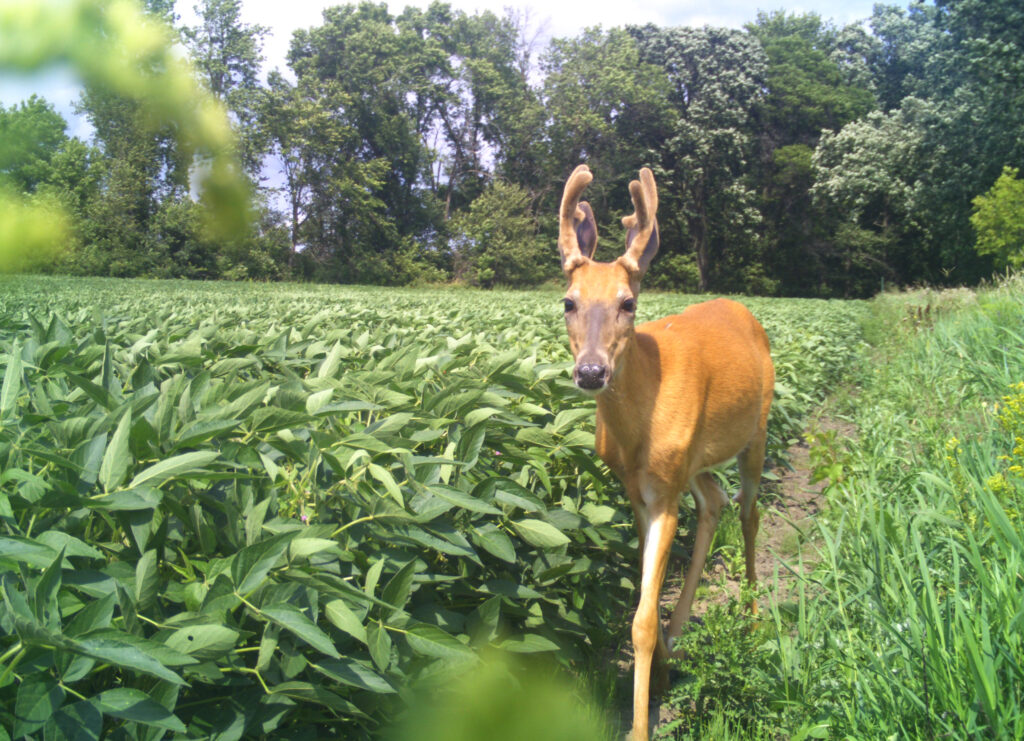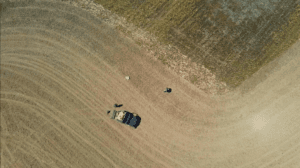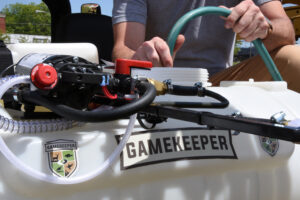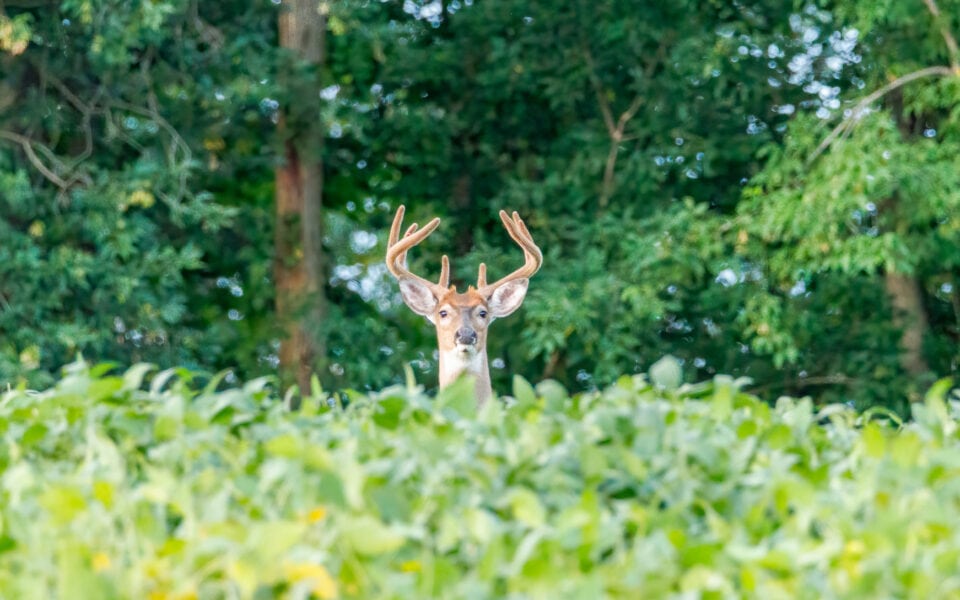In the world of food plots for white-tail deer, soybeans are often thought of as one of the top choices available. There is no shortage of amazing photography in all four seasons of the year of deer using soybeans as a major food source. I often refer to them as an ice cream crop, meaning deer universally love them and will seemingly feed in them for hours. The other reason I refer to them this way is much like a kid that is given ice cream for a treat, deer will find soybeans almost immediately after planting and browse them until nothing is left. Deer density, food plot size, and surrounding food resources are all major factors in whether a soybean planting will be successful or not. Small plots in areas with very little or no other good food sources stand a good chance of being over-browsed without the use of some type of fencing or deterrent. Larger food plots, 2-5 acres, and in areas with other row crop soybeans have a better chance of reaching a stage of growth where the plants are able to withstand the browse pressure and continue to grow.
Forage Soybeans
It should also be pointed out that there are two major parts of the soybean plant that deer seem to love equally. The leaves or forage it produces during the spring and summer, and the actual soybean that the plant makes at the end of its maturity cycle. Some land managers will plant soybeans solely for the high protein warm season forage it produces for their deer herd health knowing the plants will likely not make an actual soybean crop because of over-browsing that limits the plants ability to flower and produce a bean pod. There are also folks that will plant soybeans with the goal to provide some warm season nutrition but most of all make a good soybean crop that whitetails are so fond of in the winter months. The soybeans provide great fat and energy during the harsh weather and deer can be seen by the dozens using a field of standing beans as their main food source deep into the winter.

Dave Medvecky
When to Plant Soybeans for Deer
Soybeans can be planted anytime in the spring or summer months. Being an annual crop, soybeans grow from seed and die in one growing season so planting as early in the season as possible in warmer climates can produce better results. For maximum forage output, plant in spring 1 (one) month after the last frost for your region, or when soil temperatures consistently reach 60 degrees.
Planting a Successful Soybean Food Plot
As with many other crops, the key to having a successful soybean planting is limiting or eliminating the weed competition. Everyone has different soils and seed banks within those soils so there can be a wide variation of what weeds you may deal with in your plots. Some places have mostly grass problems, some are heavy with pesky broadleaf weeds, and a lot of places have to deal with both. The method of soybean planting used can play a big part in how much weed presence you will have to deal with.
Preparing the Soil before Planting Soybeans
 In the world of food plotting, many people have to rely on discing or tilling the ground, broadcasting soybean seed, and then covering and cultipacking. This is a very effective way to plant but almost guarantees a flush of weeds shortly after. There are a couple of ways to attack this. If you are using planting a glyphosate tolerant variety such as the Biologic Game Changer Forage Soybeans you would ideally use glyphosate as a pre-planting burn down and also include a pre-emerge like Dual Magnum, Prowl, or Valor depending on what weeds you anticipate coming out. If you don’t know, your local farmers or guys at the co-op can probably tell you what you are likely to encounter. This can really help in areas with glyphosate resistant pigweed, marestail, etc. Glyphosate is a contact only herbicide so it is only effective on things that are green and growing, it does not have any residual activity in the soil. This is why adding a pre-emergent herbicide in your burn down tank mix with glyphosate can be really effective and potentially keep you from having to do a follow up application of glyphosate later in the growing season. The idea is to get a really good contact kill and weed suppression with the contact and pre-emerge herbicides that the soybeans can canopy out and shade the ground to prevent weeds from becoming a problem.
In the world of food plotting, many people have to rely on discing or tilling the ground, broadcasting soybean seed, and then covering and cultipacking. This is a very effective way to plant but almost guarantees a flush of weeds shortly after. There are a couple of ways to attack this. If you are using planting a glyphosate tolerant variety such as the Biologic Game Changer Forage Soybeans you would ideally use glyphosate as a pre-planting burn down and also include a pre-emerge like Dual Magnum, Prowl, or Valor depending on what weeds you anticipate coming out. If you don’t know, your local farmers or guys at the co-op can probably tell you what you are likely to encounter. This can really help in areas with glyphosate resistant pigweed, marestail, etc. Glyphosate is a contact only herbicide so it is only effective on things that are green and growing, it does not have any residual activity in the soil. This is why adding a pre-emergent herbicide in your burn down tank mix with glyphosate can be really effective and potentially keep you from having to do a follow up application of glyphosate later in the growing season. The idea is to get a really good contact kill and weed suppression with the contact and pre-emerge herbicides that the soybeans can canopy out and shade the ground to prevent weeds from becoming a problem.
When To Spray Soybeans for Weeds
Whether you are using a no till drill, soybean planter, or traditional tillage as a means of planting, dealing with weeds later in the growing season is common. From a food plot/wildlife perspective we have to make the call as to whether or not it is bad enough to warrant a follow up application of glyphosate if you are using a compatible variety. The question is often asked when is the best time to spray soybeans, and there a lot of variables to that. There really aren’t any set rules or dates on this but there are a couple of things to look for. As mentioned earlier, if it is a follow up application you want to make sure there is a good representation of weeds presenting itself in the field before spraying, in other words, don’t spray as soon as the first blade of grass breaks the ground. The other side of the spectrum is not waiting too long to spray, most varieties of grasses are still easy to control around 6 inches of growth but many broadleaf varieties can be tough to kill at that stage. As a general rule with a few exceptions, I try to spray when the majority of the weeds and grasses are about 2 inches in growth.
Hopefully later in the growing season weeds are not present or at least not enough to be a problem from a wildlife perspective. If you do need a late season application of glyphosate, it is recommended not to spray once the soybean plants begin to flower or referred to as R1 stage.
Using Additives with Herbicide

There are several additives that can be used to increase herbicide efficiency particularly glyphosate. The end goal should be to kill all weeds so we are not encouraging any glyphosate resistance. AMS (ammonium sulfate) is something I don’t spray without, it is especially helpful when using well water that is hard. AMS can really be helpful when targeting tough broadleaf weeds like lambsquarter or velvetleaf. The sulfate component of AMS is negatively charged and will bind to positively charged hard water ions such as calcium, magnesium, and iron. This helps prevent the hard water ions from binding to the molecules in glyphosate and decreasing its activity in the plant. Be sure to add AMS to your tank before adding the glyphosate.
Along those same lines, a good surfactant can be especially effective if one is not already included or “loaded in” to the glyphosate brand you are using. There are a ton of choices on generic round-up (glyphosate) so be sure to read the label of what you purchase. If it calls for use of a surfactant, a non-ionic surfactant at .5-1.0% of total spray volume is needed.
Soybeans can be a very versatile and effective planting for your property. They offer some incredible nutrition and attraction for whitetails and can be utilized from Canada to Florida and anywhere in between. Take into account your plot size, deer density, surrounding food sources, etc before planting so you can know what to expect and grow a successful crop. The advantages of using glyphosate tolerant soybeans can be really helpful to Gamekeepers. Please email me at adelano@mossyoak.com if you have questions about spraying, timing, and the management of soybeans as a wildlife planting.
Tips On Planting Soybeans For Deer
In the below video, Austin Delano explains:
- When and how to plant soybeans
- Maximizing soybean germination
- Nutritional benefits of soybeans










